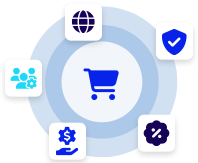Cloud native refers to a modern approach to building and running applications designed specifically for cloud environments.
Rather than relying on traditional on-premise infrastructure, cloud native development leverages the full potential of cloud computing technologies like scalable storage, databases, and computing power. This approach focuses on flexibility, scalability, and agility, making it a popular choice for businesses of all sizes, especially SaaS companies and e-commerce platforms.
At its core, cloud native architecture uses technologies like microservices and containers to break down applications into smaller, more manageable components that can be easily scaled and updated.
This architecture empowers businesses to deploy and manage apps more quickly, responding to customer needs in real-time without downtime or disruptions.
Key Benefits of Cloud Native Architecture
Cloud native development brings several advantages that traditional methods can’t match. First, applications built this way are more adaptable. Because they are cloud-based, they can be updated on the go without having to shut down the entire system, reducing disruptions and improving the user experience.
Additionally, scalability is much easier, allowing businesses to adjust their infrastructure according to demand without over-investing in physical servers. This is especially beneficial for SaaS and e-commerce companies that experience fluctuating traffic or seasonal peaks.
Key benefits of cloud native include:
- Scalability: Easily scale applications as your business grows.
- Resilience: Cloud native apps are designed to handle failures without affecting the entire system.
- Speed: Develop, test, and deploy new features faster by leveraging the flexibility of cloud infrastructure.
- Security: Modern security measures can be integrated into every layer of the architecture, ensuring strong protection for data and operations.
Cloud Native Technologies and Tools
Cloud native applications are built using a variety of modern tools and services. Microservices, for instance, break down large apps into smaller, independent services that can work together seamlessly. Containers like Docker help encapsulate these microservices and make it easy to deploy them across different environments. Kubernetes, a popular tool for container orchestration, helps manage the scaling and deployment of these services.
In addition to these, cloud native solutions often incorporate infrastructure as code (IaC), which automates the provisioning of cloud resources. Monitoring tools ensure everything runs smoothly, while serverless computing helps developers focus on writing code without worrying about managing servers. Cloud native architecture also prioritizes security, using built-in features and third-party services to protect apps and data.













